Physical Activity Health Needs Assessment Poster - HNAPS Project
VerifiedAdded on 2022/11/16
|11
|1220
|160
Project
AI Summary
This assignment presents a comprehensive overview of physical activity, encompassing its definition, various types (moderate and vigorous), and the importance of maintaining good health. It highlights key facts, distinguishing physical activity from exercise, and addresses the global issue of insufficient physical activity and its link to non-communicable diseases. The project references WHO recommendations for different age groups, detailing the recommended durations and types of activities. It also explores the benefits of regular physical activity, including improved fitness, bone health, and reduced risks of various diseases. Furthermore, the assignment discusses the level of insufficient physical activity globally and in urban areas, along with the reasons behind it. It also mentions potential risks associated with excessive physical activity. The project includes statistics on physical activity, community strategies for promoting it, and references to relevant research papers. This document presents a health needs assessment poster and presentation on physical activity, as required for the HNAPS project, focusing on the London population and utilizing data from PHE fingertips.
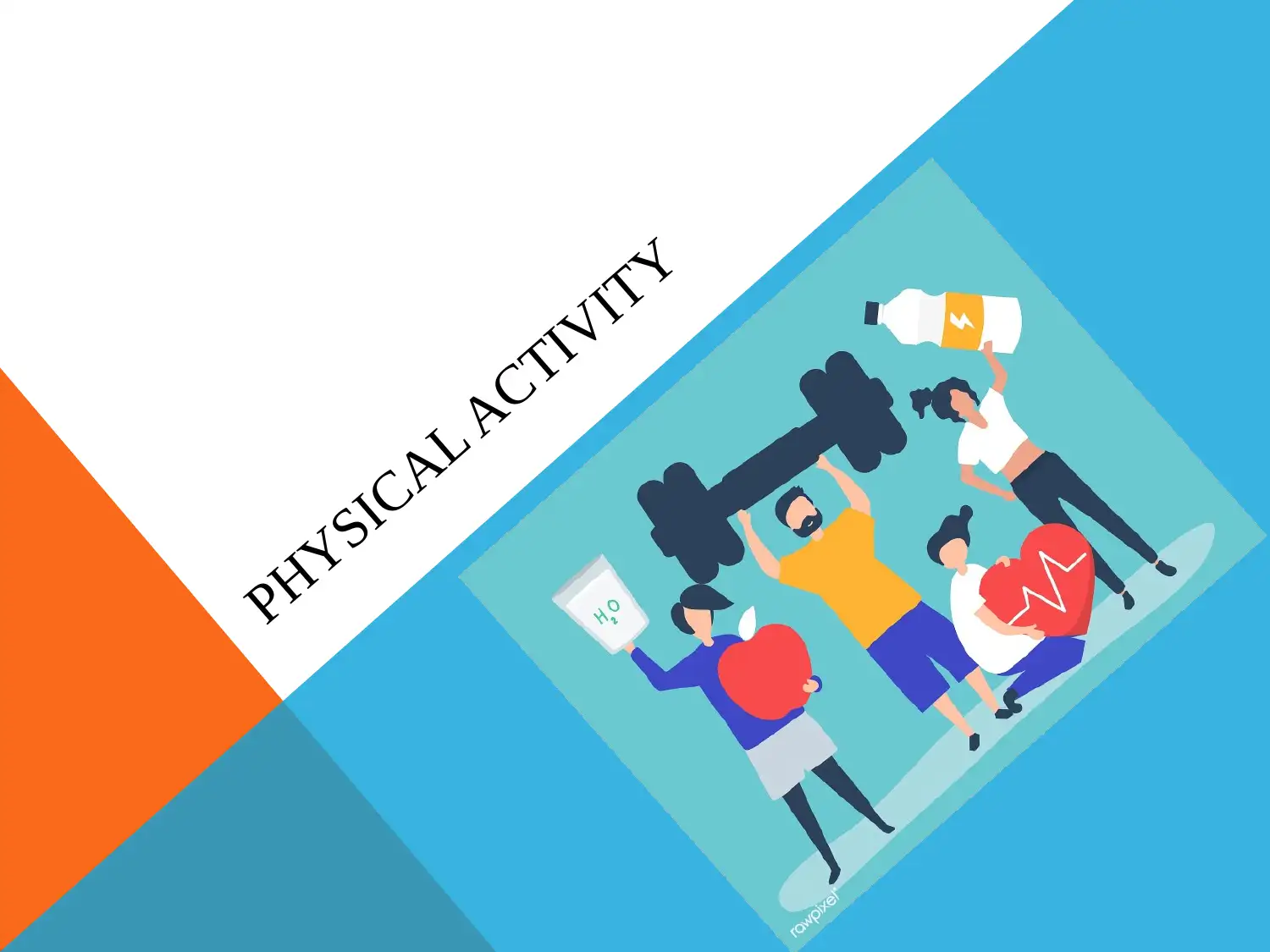
PHYSICAL ACTIVITY
Paraphrase This Document
Need a fresh take? Get an instant paraphrase of this document with our AI Paraphraser
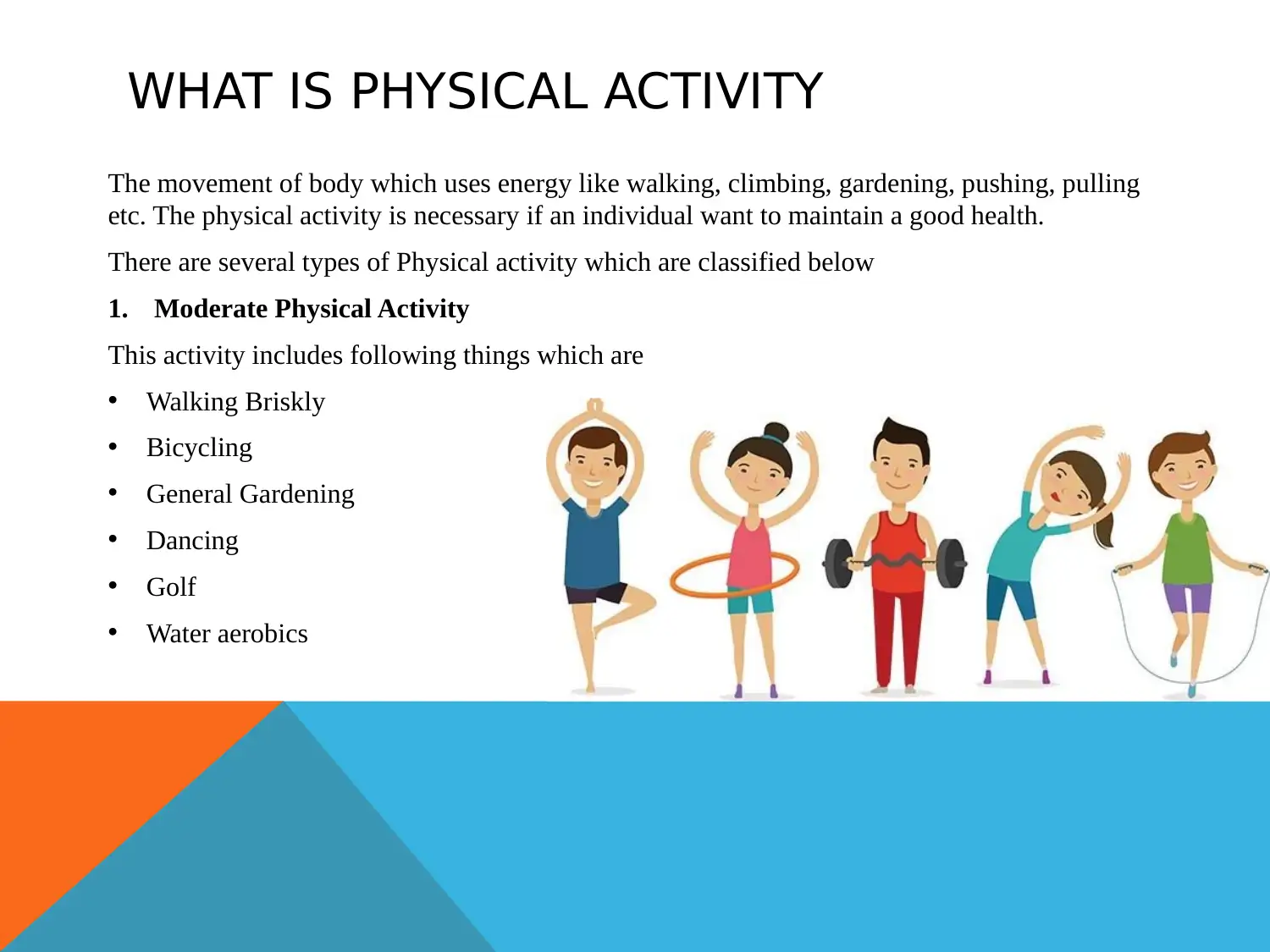
WHAT IS PHYSICAL ACTIVITY
The movement of body which uses energy like walking, climbing, gardening, pushing, pulling
etc. The physical activity is necessary if an individual want to maintain a good health.
There are several types of Physical activity which are classified below
1. Moderate Physical Activity
This activity includes following things which are
• Walking Briskly
• Bicycling
• General Gardening
• Dancing
• Golf
• Water aerobics
The movement of body which uses energy like walking, climbing, gardening, pushing, pulling
etc. The physical activity is necessary if an individual want to maintain a good health.
There are several types of Physical activity which are classified below
1. Moderate Physical Activity
This activity includes following things which are
• Walking Briskly
• Bicycling
• General Gardening
• Dancing
• Golf
• Water aerobics
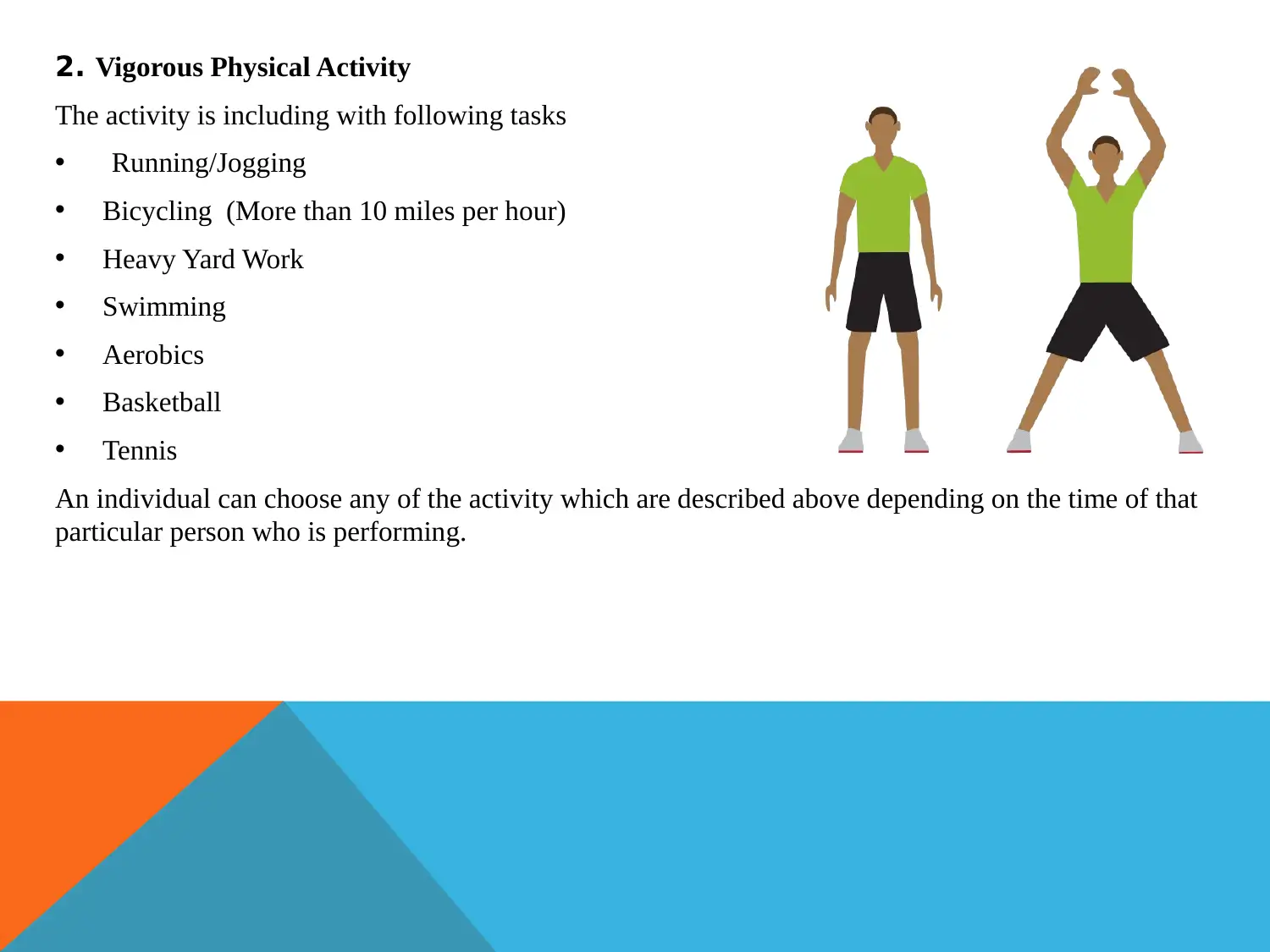
2. Vigorous Physical Activity
The activity is including with following tasks
• Running/Jogging
• Bicycling (More than 10 miles per hour)
• Heavy Yard Work
• Swimming
• Aerobics
• Basketball
• Tennis
An individual can choose any of the activity which are described above depending on the time of that
particular person who is performing.
The activity is including with following tasks
• Running/Jogging
• Bicycling (More than 10 miles per hour)
• Heavy Yard Work
• Swimming
• Aerobics
• Basketball
• Tennis
An individual can choose any of the activity which are described above depending on the time of that
particular person who is performing.
⊘ This is a preview!⊘
Do you want full access?
Subscribe today to unlock all pages.

Trusted by 1+ million students worldwide
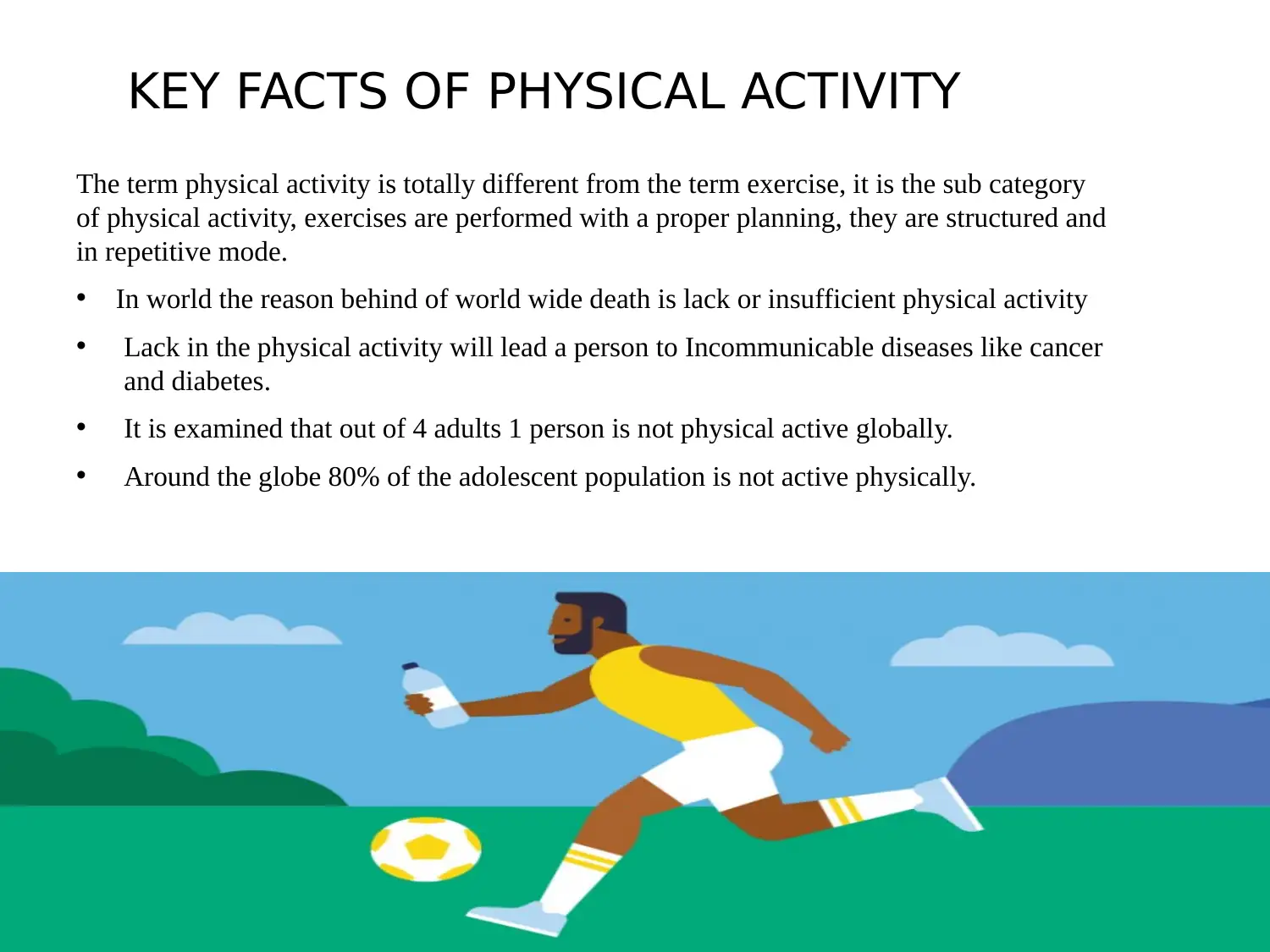
KEY FACTS OF PHYSICAL ACTIVITY
The term physical activity is totally different from the term exercise, it is the sub category
of physical activity, exercises are performed with a proper planning, they are structured and
in repetitive mode.
• In world the reason behind of world wide death is lack or insufficient physical activity
• Lack in the physical activity will lead a person to Incommunicable diseases like cancer
and diabetes.
• It is examined that out of 4 adults 1 person is not physical active globally.
• Around the globe 80% of the adolescent population is not active physically.
The term physical activity is totally different from the term exercise, it is the sub category
of physical activity, exercises are performed with a proper planning, they are structured and
in repetitive mode.
• In world the reason behind of world wide death is lack or insufficient physical activity
• Lack in the physical activity will lead a person to Incommunicable diseases like cancer
and diabetes.
• It is examined that out of 4 adults 1 person is not physical active globally.
• Around the globe 80% of the adolescent population is not active physically.
Paraphrase This Document
Need a fresh take? Get an instant paraphrase of this document with our AI Paraphraser
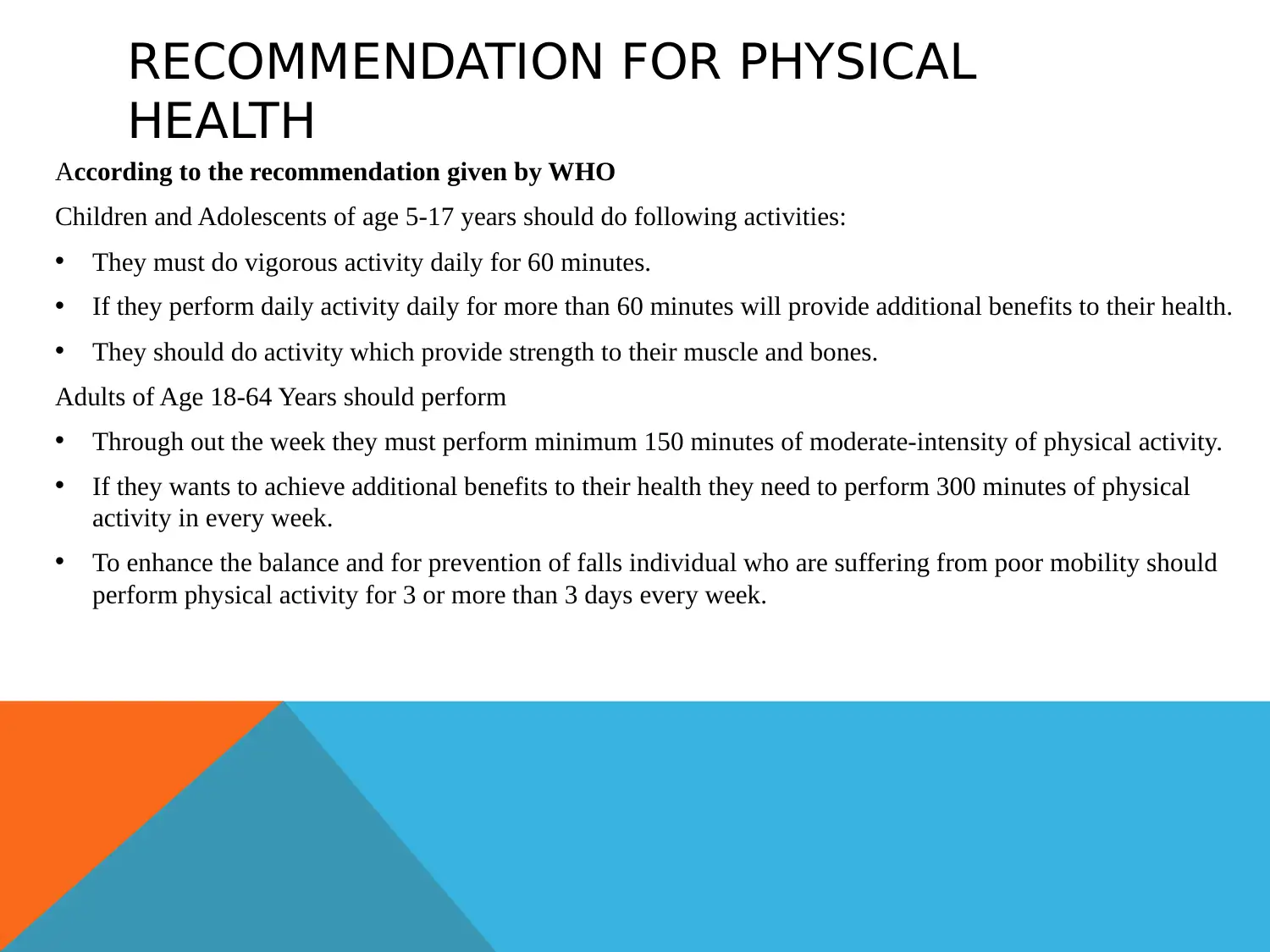
RECOMMENDATION FOR PHYSICAL
HEALTH
According to the recommendation given by WHO
Children and Adolescents of age 5-17 years should do following activities:
• They must do vigorous activity daily for 60 minutes.
• If they perform daily activity daily for more than 60 minutes will provide additional benefits to their health.
• They should do activity which provide strength to their muscle and bones.
Adults of Age 18-64 Years should perform
• Through out the week they must perform minimum 150 minutes of moderate-intensity of physical activity.
• If they wants to achieve additional benefits to their health they need to perform 300 minutes of physical
activity in every week.
• To enhance the balance and for prevention of falls individual who are suffering from poor mobility should
perform physical activity for 3 or more than 3 days every week.
HEALTH
According to the recommendation given by WHO
Children and Adolescents of age 5-17 years should do following activities:
• They must do vigorous activity daily for 60 minutes.
• If they perform daily activity daily for more than 60 minutes will provide additional benefits to their health.
• They should do activity which provide strength to their muscle and bones.
Adults of Age 18-64 Years should perform
• Through out the week they must perform minimum 150 minutes of moderate-intensity of physical activity.
• If they wants to achieve additional benefits to their health they need to perform 300 minutes of physical
activity in every week.
• To enhance the balance and for prevention of falls individual who are suffering from poor mobility should
perform physical activity for 3 or more than 3 days every week.
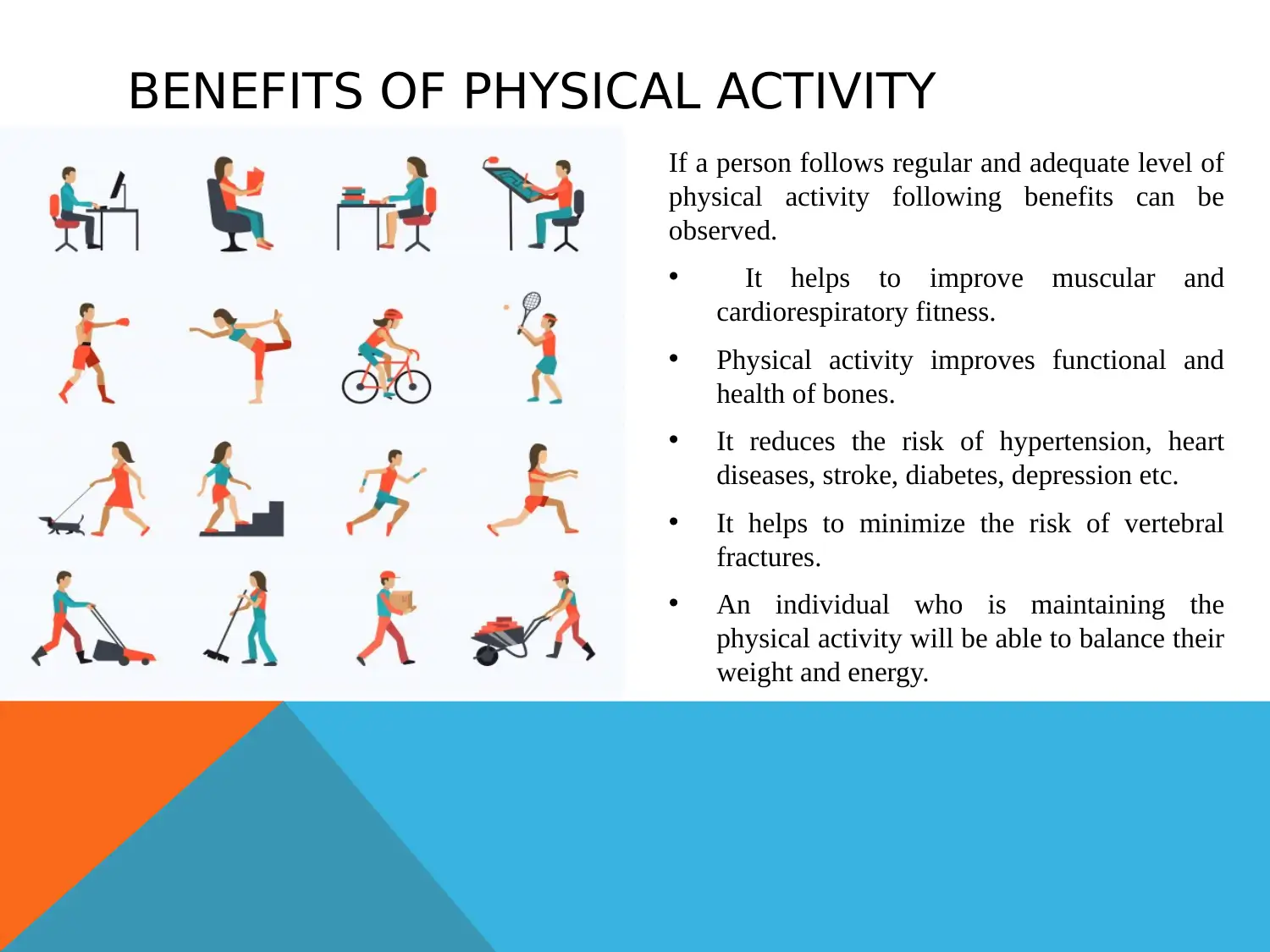
If a person follows regular and adequate level of
physical activity following benefits can be
observed.
• It helps to improve muscular and
cardiorespiratory fitness.
• Physical activity improves functional and
health of bones.
• It reduces the risk of hypertension, heart
diseases, stroke, diabetes, depression etc.
• It helps to minimize the risk of vertebral
fractures.
• An individual who is maintaining the
physical activity will be able to balance their
weight and energy.
BENEFITS OF PHYSICAL ACTIVITY
physical activity following benefits can be
observed.
• It helps to improve muscular and
cardiorespiratory fitness.
• Physical activity improves functional and
health of bones.
• It reduces the risk of hypertension, heart
diseases, stroke, diabetes, depression etc.
• It helps to minimize the risk of vertebral
fractures.
• An individual who is maintaining the
physical activity will be able to balance their
weight and energy.
BENEFITS OF PHYSICAL ACTIVITY
⊘ This is a preview!⊘
Do you want full access?
Subscribe today to unlock all pages.

Trusted by 1+ million students worldwide
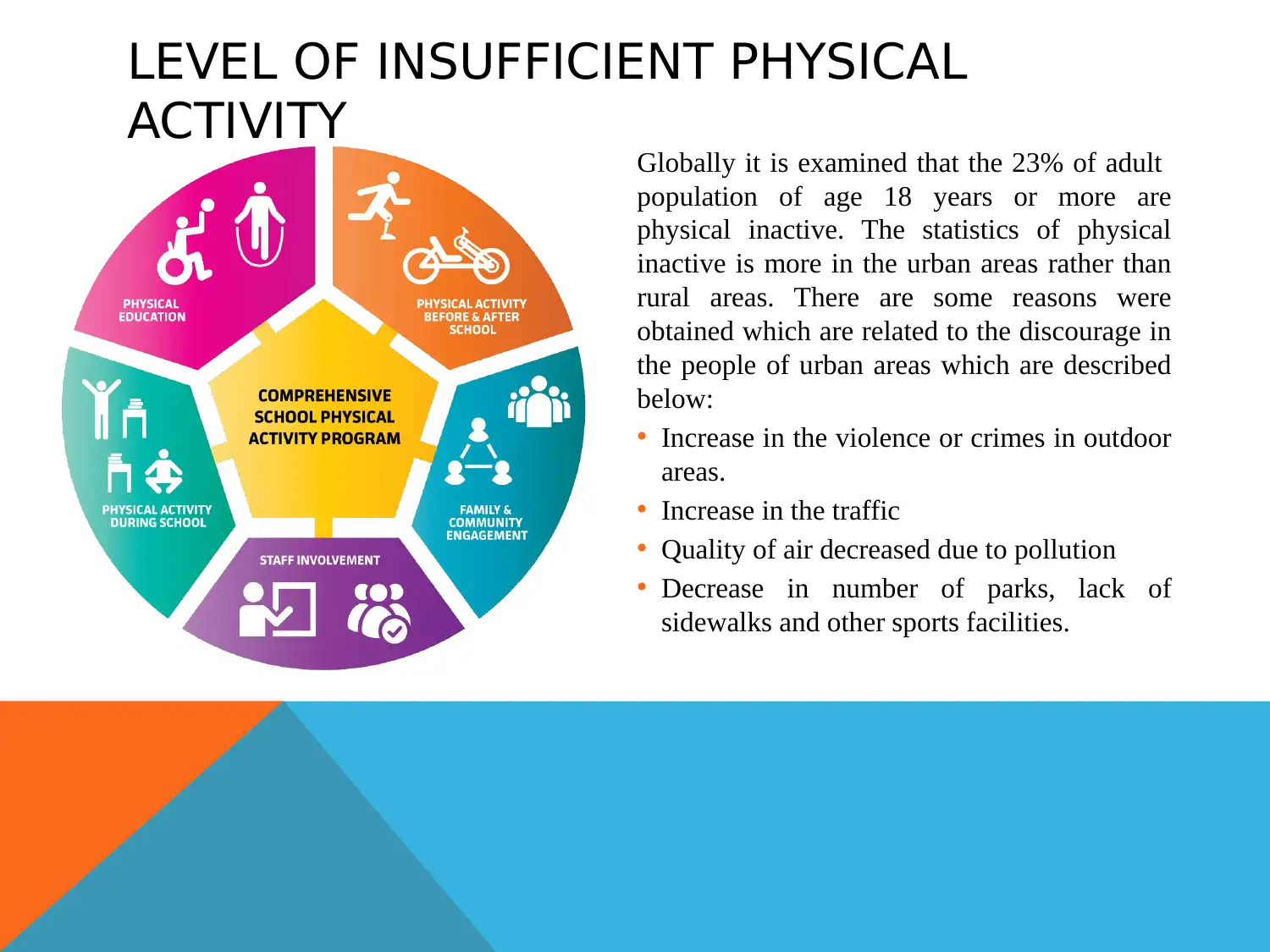
LEVEL OF INSUFFICIENT PHYSICAL
ACTIVITY Globally it is examined that the 23% of adult
population of age 18 years or more are
physical inactive. The statistics of physical
inactive is more in the urban areas rather than
rural areas. There are some reasons were
obtained which are related to the discourage in
the people of urban areas which are described
below:
• Increase in the violence or crimes in outdoor
areas.
• Increase in the traffic
• Quality of air decreased due to pollution
• Decrease in number of parks, lack of
sidewalks and other sports facilities.
ACTIVITY Globally it is examined that the 23% of adult
population of age 18 years or more are
physical inactive. The statistics of physical
inactive is more in the urban areas rather than
rural areas. There are some reasons were
obtained which are related to the discourage in
the people of urban areas which are described
below:
• Increase in the violence or crimes in outdoor
areas.
• Increase in the traffic
• Quality of air decreased due to pollution
• Decrease in number of parks, lack of
sidewalks and other sports facilities.
Paraphrase This Document
Need a fresh take? Get an instant paraphrase of this document with our AI Paraphraser
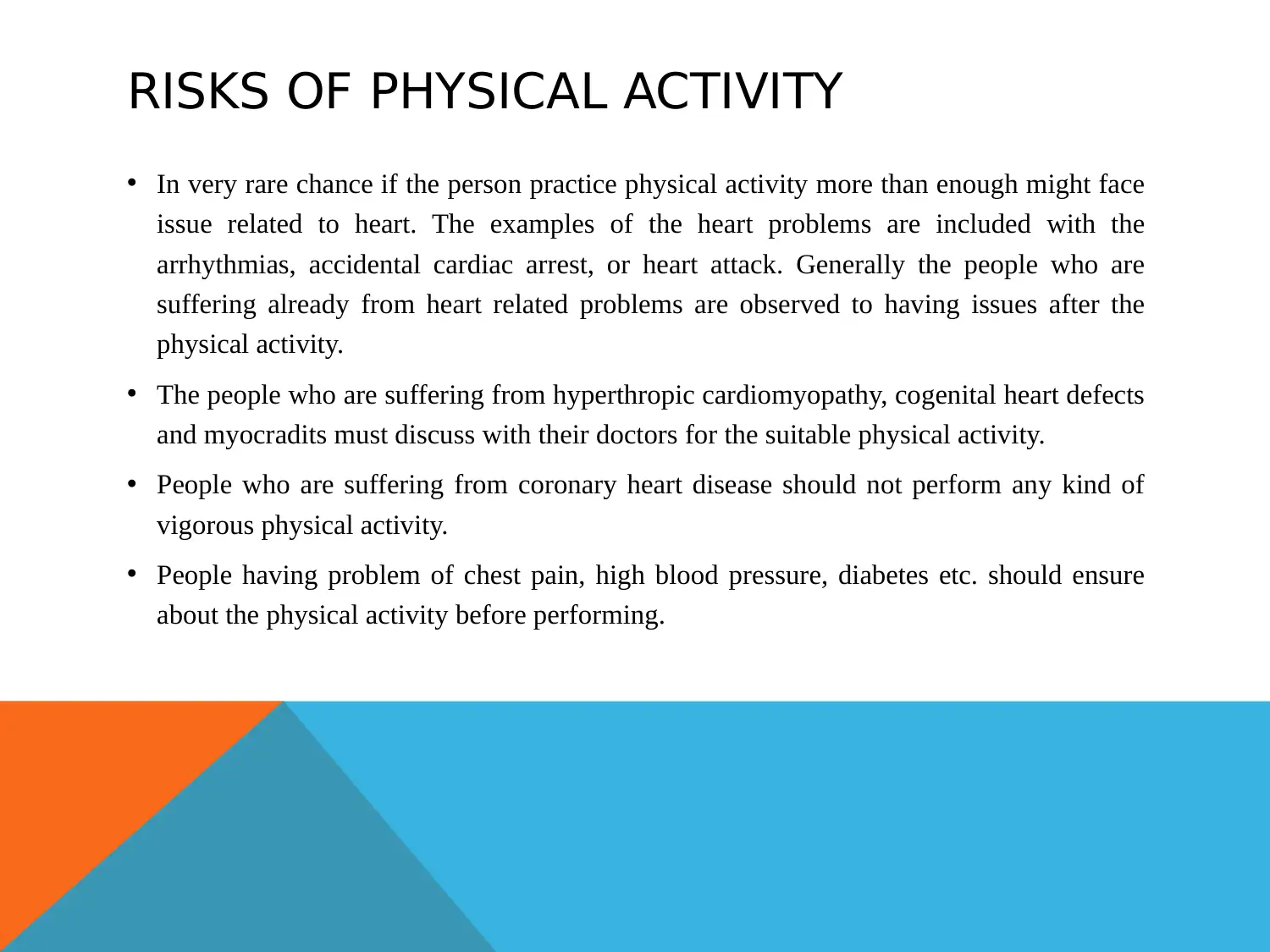
RISKS OF PHYSICAL ACTIVITY
• In very rare chance if the person practice physical activity more than enough might face
issue related to heart. The examples of the heart problems are included with the
arrhythmias, accidental cardiac arrest, or heart attack. Generally the people who are
suffering already from heart related problems are observed to having issues after the
physical activity.
• The people who are suffering from hyperthropic cardiomyopathy, cogenital heart defects
and myocradits must discuss with their doctors for the suitable physical activity.
• People who are suffering from coronary heart disease should not perform any kind of
vigorous physical activity.
• People having problem of chest pain, high blood pressure, diabetes etc. should ensure
about the physical activity before performing.
• In very rare chance if the person practice physical activity more than enough might face
issue related to heart. The examples of the heart problems are included with the
arrhythmias, accidental cardiac arrest, or heart attack. Generally the people who are
suffering already from heart related problems are observed to having issues after the
physical activity.
• The people who are suffering from hyperthropic cardiomyopathy, cogenital heart defects
and myocradits must discuss with their doctors for the suitable physical activity.
• People who are suffering from coronary heart disease should not perform any kind of
vigorous physical activity.
• People having problem of chest pain, high blood pressure, diabetes etc. should ensure
about the physical activity before performing.
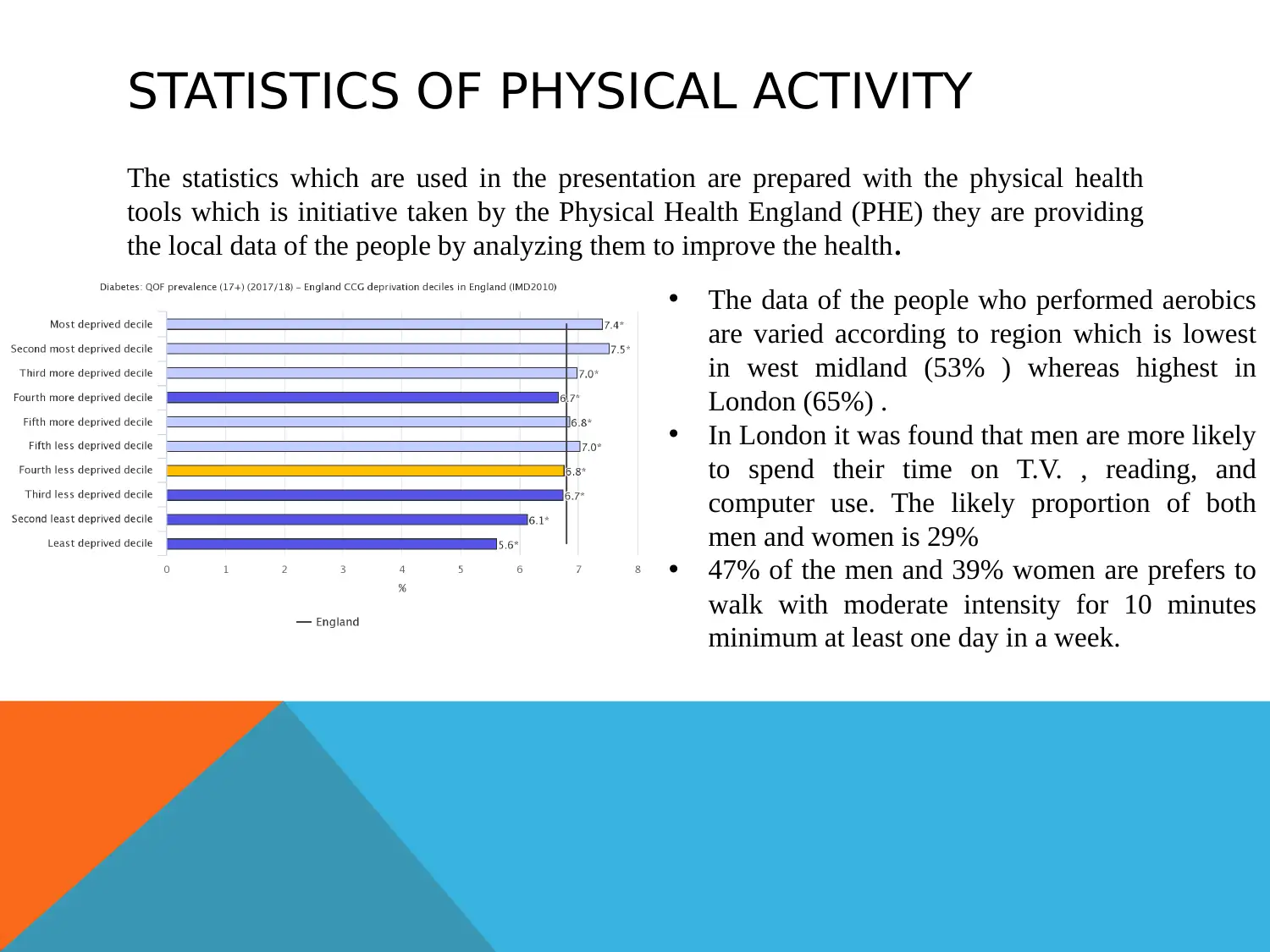
STATISTICS OF PHYSICAL ACTIVITY
The statistics which are used in the presentation are prepared with the physical health
tools which is initiative taken by the Physical Health England (PHE) they are providing
the local data of the people by analyzing them to improve the health.
• The data of the people who performed aerobics
are varied according to region which is lowest
in west midland (53% ) whereas highest in
London (65%) .
• In London it was found that men are more likely
to spend their time on T.V. , reading, and
computer use. The likely proportion of both
men and women is 29%
• 47% of the men and 39% women are prefers to
walk with moderate intensity for 10 minutes
minimum at least one day in a week.
The statistics which are used in the presentation are prepared with the physical health
tools which is initiative taken by the Physical Health England (PHE) they are providing
the local data of the people by analyzing them to improve the health.
• The data of the people who performed aerobics
are varied according to region which is lowest
in west midland (53% ) whereas highest in
London (65%) .
• In London it was found that men are more likely
to spend their time on T.V. , reading, and
computer use. The likely proportion of both
men and women is 29%
• 47% of the men and 39% women are prefers to
walk with moderate intensity for 10 minutes
minimum at least one day in a week.
⊘ This is a preview!⊘
Do you want full access?
Subscribe today to unlock all pages.

Trusted by 1+ million students worldwide
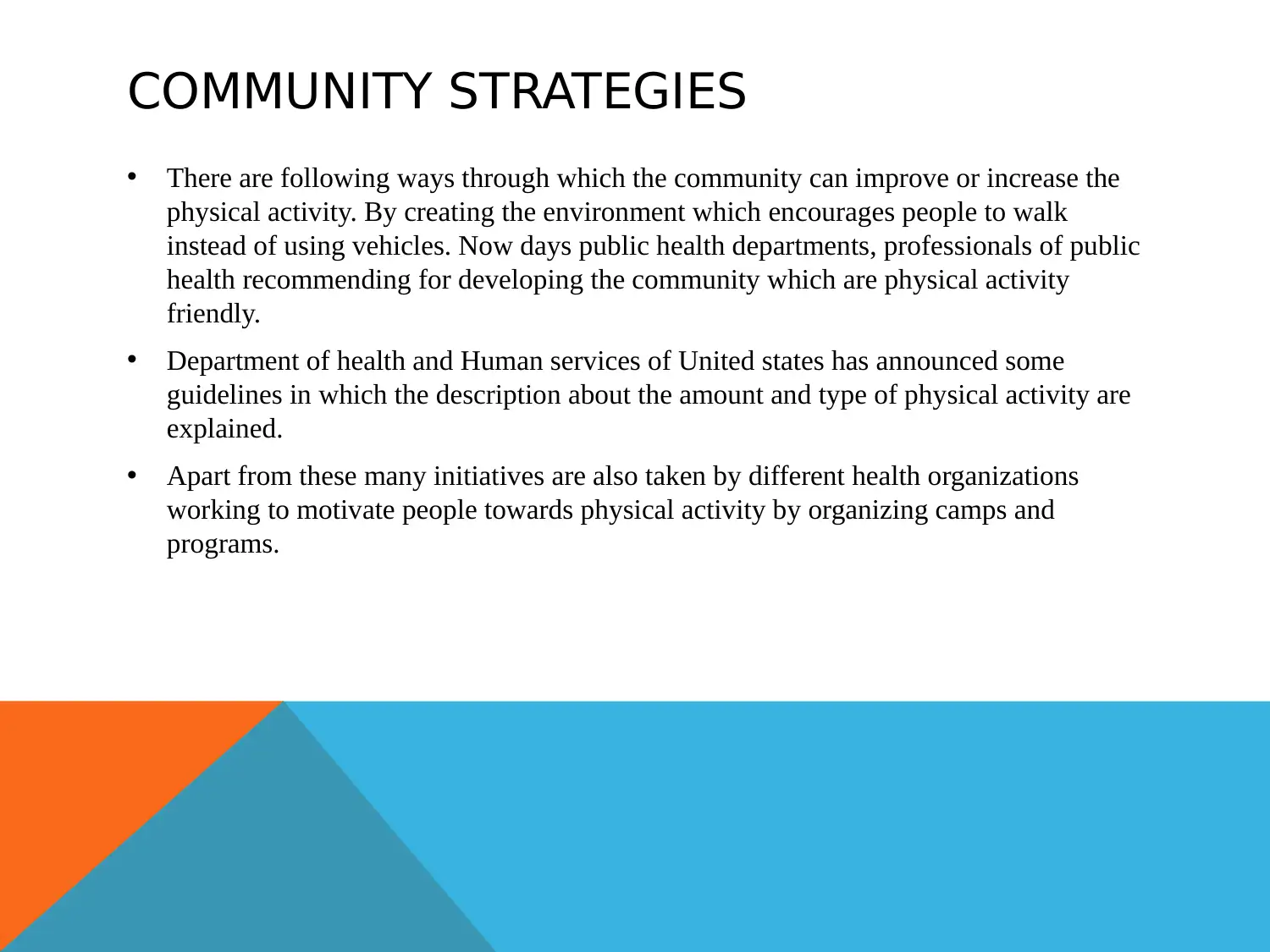
COMMUNITY STRATEGIES
• There are following ways through which the community can improve or increase the
physical activity. By creating the environment which encourages people to walk
instead of using vehicles. Now days public health departments, professionals of public
health recommending for developing the community which are physical activity
friendly.
• Department of health and Human services of United states has announced some
guidelines in which the description about the amount and type of physical activity are
explained.
• Apart from these many initiatives are also taken by different health organizations
working to motivate people towards physical activity by organizing camps and
programs.
• There are following ways through which the community can improve or increase the
physical activity. By creating the environment which encourages people to walk
instead of using vehicles. Now days public health departments, professionals of public
health recommending for developing the community which are physical activity
friendly.
• Department of health and Human services of United states has announced some
guidelines in which the description about the amount and type of physical activity are
explained.
• Apart from these many initiatives are also taken by different health organizations
working to motivate people towards physical activity by organizing camps and
programs.
Paraphrase This Document
Need a fresh take? Get an instant paraphrase of this document with our AI Paraphraser
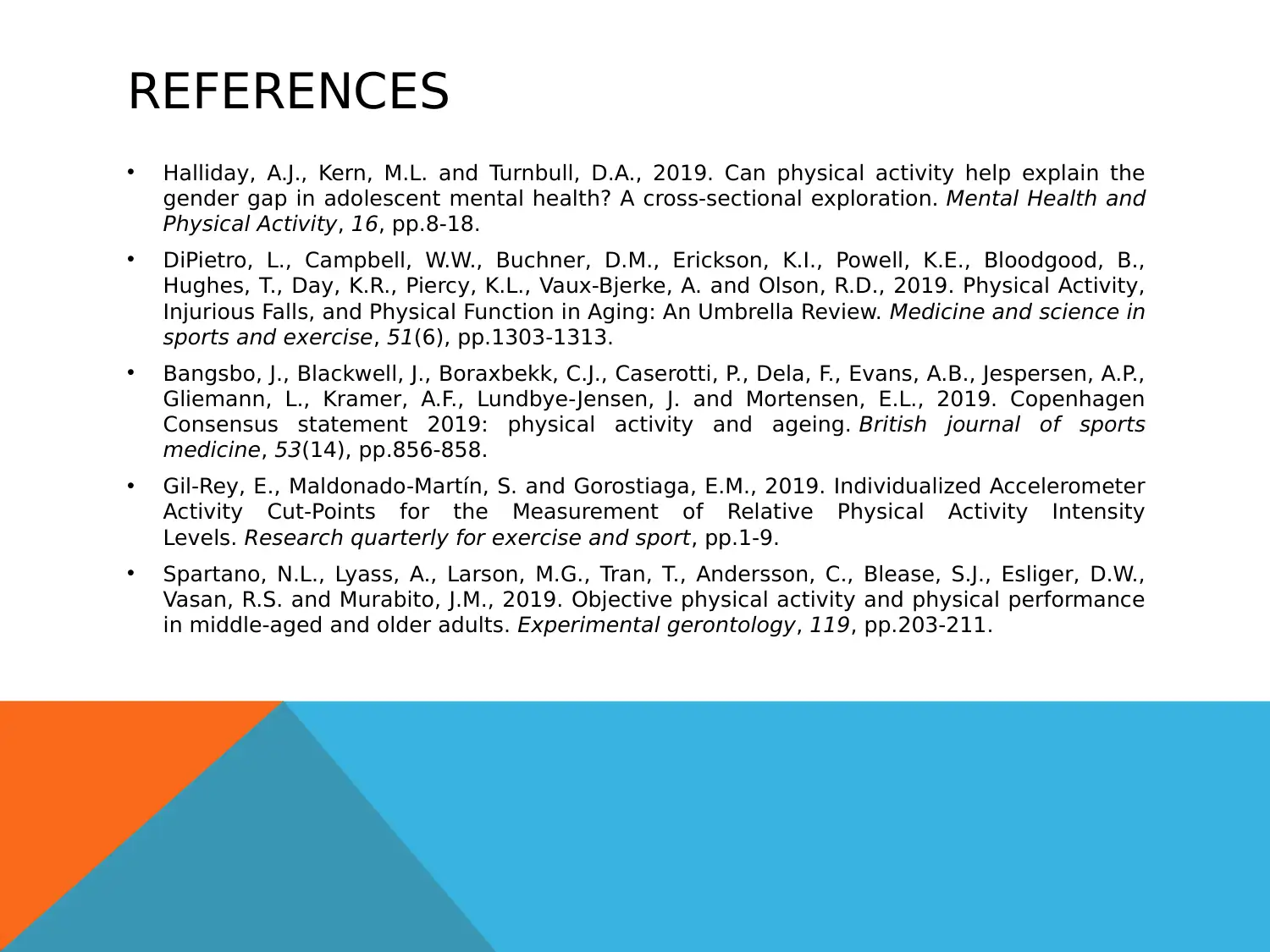
REFERENCES
• Halliday, A.J., Kern, M.L. and Turnbull, D.A., 2019. Can physical activity help explain the
gender gap in adolescent mental health? A cross-sectional exploration. Mental Health and
Physical Activity, 16, pp.8-18.
• DiPietro, L., Campbell, W.W., Buchner, D.M., Erickson, K.I., Powell, K.E., Bloodgood, B.,
Hughes, T., Day, K.R., Piercy, K.L., Vaux-Bjerke, A. and Olson, R.D., 2019. Physical Activity,
Injurious Falls, and Physical Function in Aging: An Umbrella Review. Medicine and science in
sports and exercise, 51(6), pp.1303-1313.
• Bangsbo, J., Blackwell, J., Boraxbekk, C.J., Caserotti, P., Dela, F., Evans, A.B., Jespersen, A.P.,
Gliemann, L., Kramer, A.F., Lundbye-Jensen, J. and Mortensen, E.L., 2019. Copenhagen
Consensus statement 2019: physical activity and ageing. British journal of sports
medicine, 53(14), pp.856-858.
• Gil-Rey, E., Maldonado-Martín, S. and Gorostiaga, E.M., 2019. Individualized Accelerometer
Activity Cut-Points for the Measurement of Relative Physical Activity Intensity
Levels. Research quarterly for exercise and sport, pp.1-9.
• Spartano, N.L., Lyass, A., Larson, M.G., Tran, T., Andersson, C., Blease, S.J., Esliger, D.W.,
Vasan, R.S. and Murabito, J.M., 2019. Objective physical activity and physical performance
in middle-aged and older adults. Experimental gerontology, 119, pp.203-211.
• Halliday, A.J., Kern, M.L. and Turnbull, D.A., 2019. Can physical activity help explain the
gender gap in adolescent mental health? A cross-sectional exploration. Mental Health and
Physical Activity, 16, pp.8-18.
• DiPietro, L., Campbell, W.W., Buchner, D.M., Erickson, K.I., Powell, K.E., Bloodgood, B.,
Hughes, T., Day, K.R., Piercy, K.L., Vaux-Bjerke, A. and Olson, R.D., 2019. Physical Activity,
Injurious Falls, and Physical Function in Aging: An Umbrella Review. Medicine and science in
sports and exercise, 51(6), pp.1303-1313.
• Bangsbo, J., Blackwell, J., Boraxbekk, C.J., Caserotti, P., Dela, F., Evans, A.B., Jespersen, A.P.,
Gliemann, L., Kramer, A.F., Lundbye-Jensen, J. and Mortensen, E.L., 2019. Copenhagen
Consensus statement 2019: physical activity and ageing. British journal of sports
medicine, 53(14), pp.856-858.
• Gil-Rey, E., Maldonado-Martín, S. and Gorostiaga, E.M., 2019. Individualized Accelerometer
Activity Cut-Points for the Measurement of Relative Physical Activity Intensity
Levels. Research quarterly for exercise and sport, pp.1-9.
• Spartano, N.L., Lyass, A., Larson, M.G., Tran, T., Andersson, C., Blease, S.J., Esliger, D.W.,
Vasan, R.S. and Murabito, J.M., 2019. Objective physical activity and physical performance
in middle-aged and older adults. Experimental gerontology, 119, pp.203-211.
1 out of 11
Related Documents
Your All-in-One AI-Powered Toolkit for Academic Success.
+13062052269
info@desklib.com
Available 24*7 on WhatsApp / Email
![[object Object]](/_next/static/media/star-bottom.7253800d.svg)
Unlock your academic potential
Copyright © 2020–2025 A2Z Services. All Rights Reserved. Developed and managed by ZUCOL.





